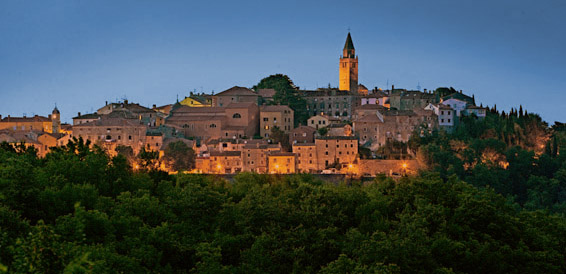
Istra and Kvarner
The Istrian peninsula and the Kvarner Bay are the northern-most part of the Croatian coast. The area stretches from Savudrija in the north to the island of Pag in the south. This is the region noticeably influenced by the inland: the Istrian mainland, Gorski kotar and Velebit.
The cuisine of the region is higly regarded, rich and diverse, offering fresh seafood, indigenous wild game, highly praised white Istrian truffles, spiced Istrian prosciutto, cheese and lamb from the island of Pag and exceptionally good wine.
With its picturesque landscape, Istria is a true feast for the eyes. Countless streams that flow to the sea through deep valleys and gullies invoke ancient local myths about giants. The rolling hills with small towns crowning their peaks and overlooking the fields and valleys, white-topped mountains, valleys with lush wheat fields, vineyards and olive groves on the hillsides, and the crisp blue sea make up this magical landscape. A few miles off the Istrian coast lies the Brijuni national park, one of the most beautiful and exotic archipelagos in Croatia.
As you travel further in Istria you will notice more charming details: church facades and portals, tiny village alleyways with their unique architectural spirit, babbling streams of fresh water, blossoming cherries leaning over the streets.
Just like the climate, nature, towns, the people are also warm and friendly.
The area of the Kvarner Bay is a pure and clean region of rich cultural and historical heritage and equally interesting cuisine.
It is a priceless blend of sea, islands and mountains within a relatively small area. In a single day you can sail on a yacht, swim in the sea, and then relax in the shade of the nearby mountain forest, sometimes even ski. Risnjak and North Velebit national parks, located up in the mountains of Gorski kotar and Velebit, are a must-see for anyone who cares about nature and enjoys beautiful mountain scenery.Last but not least, the Opatija Riviera is a place to visit for romantic walks along the beach or candlelit dinners overlooking the sea.
As the northern-most part of the Croatian Adriatic coast, Istria and the Kvarner region are under a much stronger mainland influence than the rest of the Adriatic. The area has a slightly lower average temperature throughout the year and more rain compared to Dalmatia. Due to its geographical characteristics, Istria is often under the influence of bura, a typically dry, cold and often gusty north-easterly wind blowing from the mountains on the eastern side of the Adriatic sea. Jugo, another major wind, blowing from the south-east, is the strongest, especially in the winter. Lebic is an occasional wind that appears in Istria when jugo turns into a southwesterly wind southwest and it is often accompanied by local thunder storms.
The Kvarner Bay is surrounded by the high mountains of Gorski kotar and Ucka, which affect the weather conditions in the area significantly. It is the area of the Croatian Adriatic coast with the highest annual rainfall, the rain mostly falling in October and November and slightly in July and August. During winter, bura is the strongest around Rijeka, in the Kvarner Channel, Senjska Vrata and the south-eastern parts of the island of Pag, with its intensity dropping southwards, towards Vela and Srednja Vrata. The islands of Cres and Losinj and their north - south orientation turn jugo in the Kvarner area into a south-westerly, rather than south-easterly wind like in the rest of the Croatian Adriatic. A common occurance during the summer is weak to mild wind called maestral.
During winter, one of the areas in which one should be careful of the weather conditions is the long stretch of the Velebit channel. Bura is strong here during the winter period, lifting the sea dust into the air, substantially reducing visibility. However, this is an area with the weakest jugo.